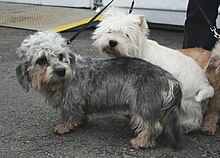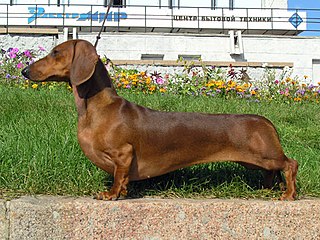
The dachshund, also known as the wiener dog or sausage dog, badger dog and doxie, is a short-legged, long-bodied, hound-type dog breed. The dog may be smooth-haired, wire-haired, or long-haired. Coloration varies.
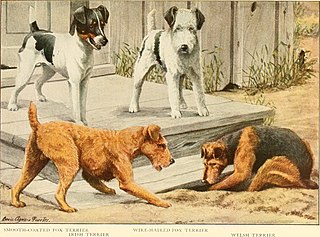
Terrier is a type of dog originally bred to hunt vermin. A terrier is a dog of any one of many breeds or landraces of the terrier type, which are typically small, wiry, game, and fearless. There are five different groups of terrier, with each group having different shapes and sizes.

The Scottish Terrier, popularly called the Scottie, is a breed of dog. Initially one of the highland breeds of terrier that were grouped under the name of Skye Terrier, it is one of five breeds of terrier that originated in Scotland, the other four being the modern Skye, Cairn, Dandie Dinmont, and West Highland White terriers. They are an independent and rugged breed with a wiry outer coat and a soft dense undercoat. The first Earl of Dumbarton nicknamed the breed "the diehard". According to legend, the Earl of Dumbarton gave this nickname because of the Scottish Terriers' bravery, and Scotties were also the inspiration for the name of his regiment, The Royal Scots, Dumbarton’s Diehard. Scottish Terriers were originally bred to hunt vermin on farms.
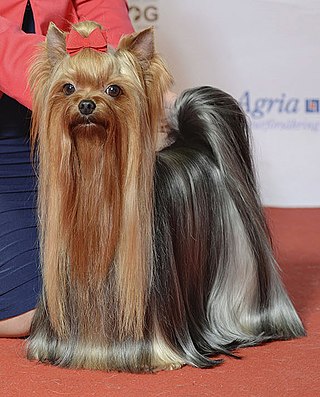
The Yorkshire Terrier, also known as a Yorkie, is a British breed of toy dog of terrier type. It is among the smallest of the terriers and indeed of all dog breeds, with a weight of no more than 3.2 kg (7 lb). It originated in the nineteenth century in the English county of Yorkshire, after which it is named. The coat is tan on the head and dark steel-grey on the body; no other colour is accepted by either The Kennel Club or the Fédération Cynologique Internationale.
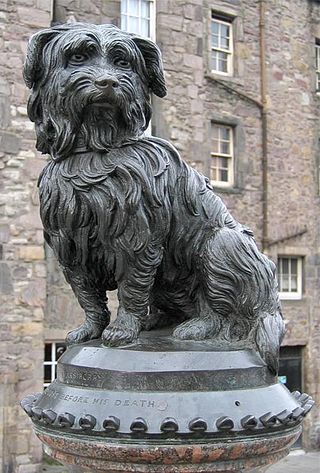
Greyfriars Bobby was a Skye Terrier or Dandie Dinmont Terrier who became known in 19th-century Edinburgh for spending 14 years guarding the grave of his owner until he died on 14 January 1872. The story continues to be well known in Scotland, through several books and films. A prominent commemorative statue and nearby graves are a tourist attraction.

The West Highland White Terrier, commonly known as the Westie, is a breed of dog from Scotland with a distinctive white harsh coat with a somewhat soft white undercoat. It is a medium-sized terrier, although with longer legs than other Scottish breeds of terrier. It has a white double coat of fur which fills out the dog's face, giving it a rounded appearance.

The Australian Terrier is a small breed of dog of the terrier type. The breed was developed in Australia, although the ancestral types of dogs from which the breed descends were from Great Britain.

The soft-coated Wheaten Terrier is a pure-breed terrier originating from Ireland. Wheatens typically have one of two coat types: Irish or Heavy (American). The Irish coat is generally silkier and wavier than the Heavy, or American coat, which is thicker and fuller. Wheatens are generally friendly and playful, and tend to get along well with children and other dogs.

The Bedlington Terrier is a breed of small dog named after the mining town of Bedlington, Northumberland in North East England. Originally bred to hunt, the Bedlington Terrier has since been used in dog racing, numerous dog sports, as well as in conformation shows and as a companion dog. It is closely related to the Dandie Dinmont Terrier, Whippet and Otterhound.

The Cairn Terrier is a terrier breed originating in the Scottish Highlands and recognised as one of Scotland's earliest working dogs.

The Sealyham Terrier is a rare Welsh breed of small to medium-sized terrier that originated in Wales as a working dog. It is principally a white-bodied, rough-coated breed, developed in the mid-to-late-19th century by Captain John Edwardes at Sealyham House, Pembrokeshire.

The Border Terrier is a British breed of small, rough-coated terrier. It originates from the area of the Anglo-Scottish border, and shares ancestry with the Dandie Dinmont Terrier and the Bedlington Terrier from the same area. The dogs were traditionally used in fox-hunting, and worked with the Border Hunt in Northumberland.

The Kerry Blue Terrier is a breed of dog. Originally bred to control vermin including rats, rabbits, badgers, ferrets, foxes, otters, hares, deer, and even wolves, over time the Kerry became a general working dog used for a variety of jobs including herding cattle and sheep. Despite a Kerry Blue winning Crufts in 2000, it remains an "unfashionable" breed, and is distinctly uncommon; however, it is not as threatened as some of the other terrier breeds such as the Skye Terrier, Sealyham Terrier, and Dandie Dinmont Terrier.

The Glen of Imaal Terrier is a breed of dog of the terrier category and one of four Irish terrier breeds. It is sometimes called the Irish Glen of Imaal Terrier or the Wicklow Terrier, and the name of the breed is often shortened by fanciers to just Glen.

An earthdog test or earthdog trial tests the working ability and instinct of the small, often short-legged terriers or Dachshunds. These dogs were bred to hunt vermin and other quarry which lived in underground dens. Earthdog den tests involve human-made tunnels that the dogs must navigate, while scenting a rat, "the quarry". The dog must follow the scent to the quarry and then "work" the quarry. Depending on the sanctioning organization, "working" means barking, scratching, staring, pawing, digging; any active behavior. The quarry is protected at all times by wooden bars across the end of the tunnel. The hunting encounter is controlled, and neither the dog nor the quarry are endangered by the activity.

The Paisley Terrier was a breed of terrier-type dog that is now extinct. Originating in Scotland, the Paisley Terrier was bred primarily as a pet and showdog version of the Skye Terrier, and was the progenitor of today's Yorkshire Terrier. The breed was called the Paisley Terrier since most of the dogs came from that location, but it was also called the Clydesdale Terrier, for another location in the Clyde Valley where the dogs were bred.

Old Jock (1859–1871), was a Fox Terrier famous during the late 19th and early 20th centuries. A mostly white dog, he ran briefly with a hunting kennel before becoming a show dog, most notably with a victory at the show which popularised the Fox Terrier. His main show rivalry was with a dog named Tartar, and along with a dog named Trap, the three were popular sires of the Fox Terrier breed. He was also involved in the early formation of the Jack Russell Terrier and the Dandie Dinmont Terrier breeds.

The Haining is a country house and estate in Selkirk in the Scottish Borders. The present house dates from the 1790s, and was a property of the Pringle family. In 2009, the house and grounds were bequeathed to The Haining Charitable Trust which manages the estate for the benefit of the people of Selkirkshire and the wider public. The Haining Charitable Trust is now working on developing the building as a centre for exhibitions and events, highlighting art, culture and history. The House is currently being refurbished and will be let out for various events and functions. The Old Coach House and Stable outbuildings have been refurbished and now offer six brand new artists studios. Holiday apartments, The Ettrick, and The Yarrow, and the two-beroomed, Dairy Cottage, are also now available within the grounds available for booking via Visit Scotland. The "Old Ginger" statue is located in the kennel yard.
Rawdon Briggs Lee was an English dog breeder and writer on dogs.




